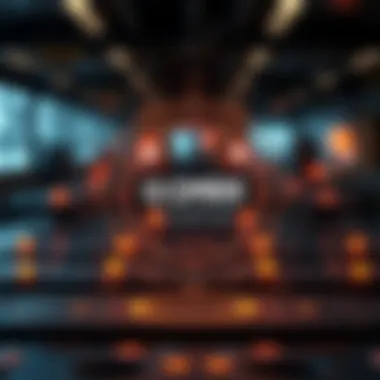DMRR Blockchain: Comprehensive Overview and Insights


Intro
The world of cryptocurrency is constantly evolving, and in the midst of this landscape, the DMRR blockchain has made quite an impression. As we delve into this article, we aim to dissect the intricate layers of the DMRR blockchain, touching upon its foundational architecture, operational mechanics, and the multifaceted implications this technology bears for investors and developers alike.
We’re not just looking at a surface-level overview; instead, we’ll explore how DMRR handles consensus, tackles scalability, and finds its place within various industries. By examining these components, we’ll gain insight into how the DMRR blockchain might revolutionize digital transactions and contribute to ongoing advancements in the tech sector.
As we embark on this exploration, it’s crucial to lay a groundwork of crypto concepts, ensuring our audience has the necessary terminology and framework to understand the more intricate discussions ahead. With this solid footing, we are ready to venture into the specifics of the DMRR blockchain.
Prelims to DMRR Blockchain
Understanding the DMRR blockchain is as essential today as knowing how to navigate the seas in the age of exploration. Its impact on the financial landscape and beyond deserves thorough examination. DMRR isn't just another player; it's a game-changer in the realm of decentralized technologies. This introduction sets the stage for a deeper exploration of its mechanics, ideologies, and the potential it harbours for developers and investors alike.
Defining Blockchain Technology
Blockchains are a combination of technological innovation and a philosophical undercurrent, stemming from a need for trust and transparency in digital interactions. At their core, blockchains are decentralized databases that enable peer-to-peer transactions without the need for a central authority. Each transaction is stored in a block, and once a block is filled, it gets added to a chain of previous transactions, forming a permanent record that cannot be altered without consensus from the network.
Blockchains utilize cryptographic principles to ensure security and integrity, allowing users to conduct transactions with confidence. This decentralized nature means that no single entity controls the network, which paves the way for a more democratic system. With the rise of decentralized finance and other applications, the practical implications of blockchain technology are felt across sectors such as finance, healthcare, and supply chain management.
"Blockchain technology allows trustless interactions among parties that do not know each other, fostering a new level of efficiency in the digital world."
The Genesis of DMRR Blockchain
The inception of DMRR Blockchain traces back to a vision: create a platform that addresses the critical shortcomings of earlier blockchain technologies. Launched in the early 2020s, the creators focused on enhancing speed, scalability, and security. DMRR arose from the recognition that as blockchain grows, so do the demands and expectations of its users.
From concept to reality, the DMRR blockchain's development was a collaborative effort involving seasoned developers, cryptographers, and industry analysts. They envisioned a blockchain that didn't just compete but excelled, adopting a unique approach that integrates various consensus mechanisms and innovative technological solutions.
The goal was clear: build a blockchain that not only serves transactions but also extends to applications that can reshape industries. Every bit of progress and iteration was aimed at realizing the ultimate potential of blockchain – a transformation that can influence the future of finance and data across the globe.
This journey offers insights into the foundational principles that guide DMRR and lays a solid groundwork for understanding its architecture and operational mechanisms in the following sections.
Core Architecture of DMRR
The core architecture of DMRR is fundamental to its operational efficacy and that’s where the rubber meets the road for realizing its potential in the dynamic world of blockchain technology. Understanding this architecture means unpacking how DMRR functions at a basic level and the vital elements that contribute to its overall performance. This section will delve into the nuances of decentralization, data storage, and security protocols—three pillars that hold the entire structure together. Knowing these intricacies is crucial for investors, developers, and anyone with a vested interest in the future of blockchain technology.
Decentralization and Network Structure
Decentralization stands at the heart of DMRR, a concept that brings about transparency and trustworthiness. With a decentralized network structure, data does not reside on a single entity but is distributed across multiple nodes, each holding a copy of the complete blockchain. The backbone of this distribution stems from peer-to-peer connections—allowing every node to interact directly with one another without a middleman. This ensures that no single point of failure exists, enhancing the resilience of the network.
There’s a real beauty to how DMRR structures its decentralization. Any participant within the network can join without facing excessive barriers. This openness encourages collaboration, fortifying the ecosystem while simultaneously empowering users. Collaboration breeds innovation; thus, ideas can sprout, and new applications can emerge from the collective input.
The downside, however, is that the greater the number of nodes, the more complex consensus becomes, demanding efficient algorithms to keep everything in line. It’s a balancing act, but one that DMRR seems to navigate quite well.
Data Storage Mechanisms
Shifting gears to data storage, DMRR adopts a layered approach, utilizing several mechanisms to ensure efficient storage and retrieval of information. Traditional blockchains often struggle with storage overhead, but DMRR has pioneered innovative solutions to sidestep these pitfalls. For one, it employs sharding—breaking up data into smaller, manageable pieces stored across different nodes. This not only enhances performance but also boosts scalability, relieving the bottleneck tendencies typically associated with larger datasets.
Moreover, DMRR champions the use of directed acyclic graphs (DAGs) in its storage architecture, mitigating issues related to transaction speeds and confirming multiple transactions simultaneously. This method allows for a more fluid experience, especially in high-demand scenarios, as transactions cascade seamlessly.
All said and done, robust data storage mechanisms empower DMRR to handle the increasing demand for efficiency without sacrificing security or integrity.
Security Protocols Employed
The security of any blockchain is paramount, and DMRR layers its architecture with a range of sophisticated security protocols designed to thwart malicious activities. One of the standout features is the integration of multi-factor authentication, which adds an essential layer of protection. Users don’t just rely on passwords; they engage in a ballet of verification methods, reducing the chances of unauthorized access.


In addition, DMRR employs cryptographic techniques that are not only advanced but are also continuously evolving. Using hash functions ensures that data integrity is maintained while making it incredibly difficult for unauthorized parties to tamper with information. Coupled with regular network audits and the implementation of formal methods for verification, the security framework is robust and reliable.
Furthermore, communication within the network is encrypted end-to-end, safeguarding user interactions from potential eavesdroppers. This is a critical aspect, particularly as the blockchain space continues to mature and garner the attention of regulators and potential adversaries alike. In a world where data breaches happen at an alarming rate, the security protocols present in DMRR embody a commitment to protecting not just the network but the users who rely on it.
Overall, the core architecture of DMRR offers a glimpse into its forward-thinking design. By blending decentralization, innovative data storage methods, and resilient security measures, DMRR sets itself apart as a capable competitor in the blockchain landscape. As it continues to evolve, understanding these foundational elements provides a clearer picture of its potential trajectory.
Consensus Algorithms Within DMRR
In a world where blockchain technology is steadily reshaping industries, the consensus algorithms of the DMRR blockchain play a pivotal role in ensuring that transactions remain trustless and transparent. Understanding these algorithms is crucial, not just for developers implementing them, but also for investors and analysts eager to gauge the blockchain’s operational efficiency and scalability. This section delves into the various consensus mechanisms within DMRR, highlighting their specific advantages, potential drawbacks, and innovations that set DMRR apart in the crowded space of blockchain technology.
Overview of Consensus Mechanisms
Consensus mechanisms act as the backbone of any blockchain. They are the processes by which transaction data is verified and agreed upon by network participants. In simpler terms, they ensure that everyone in the blockchain community agrees on the current state of the ledger. In the case of DMRR, several mechanisms are implemented, each tailored to meet the unique demands of scalability, speed, and security.
- Types of Consensus Mechanisms:
- Proof of Work (PoW): Traditionally used in Bitcoin, it replaces transactions with cryptographic puzzles.
- Proof of Stake (PoS): This approach uses validators who stake their coins to affirm transactions, thereby reducing energy consumption.
- Delegated Proof of Stake (DPoS): Involves voters electing validators, which can enhance scalability and transaction speed.
"In the world of blockchain, reaching a consensus isn’t just about numbers; it's about trust built through complex algorithms."
Finding the right balance between decentralization and efficiency can be daunting, but the DMRR blockchain employs a hybrid approach that integrates elements from various consensus methods to maintain security while optimizing performance.
Proof of Work vs Proof of Stake
When comparing Proof of Work (PoW) with Proof of Stake (PoS) within DMRR, it’s essential to grasp the underlying philosophies and implications of each. PoW relies on computational power, which means miners compete to solve complex mathematical problems in order to add new blocks. While this method increases network security, it often demands significant energy consumption, leading to environmental concerns.
On the other side of the fence, PoS offers a more eco-friendly alternative, as it selects validators based on the number of coins they hold, or "stake." This minimizes the energy footprint but does raise questions around centralization—especially if a few parties control the majority of the stakes. Here are key differences:
- Energy Consumption: PoW is energy-intensive, while PoS is more sustainable.
- Security: PoW is more secure against certain types of attacks but more vulnerable to centralization due to the computational powe.
- Rewards Distribution: PoW payouts can favor miners with the most resources, while PoS rewards are more evenly distributed over time.
Incorporating both methodologies allows DMRR to leverage the strengths of PoW for critical transactions while adopting PoS for regular operations, thus fostering a more balanced and efficient environment.
Innovations in Consensus Approaches
As the blockchain landscape evolves, so too does the need for innovative consensus algorithms that address emerging challenges like scalability issues, transaction speeds, and decentralization. DMRR is at the forefront of such innovation, implementing unique solutions that not only address inertia but also lay the groundwork for future enhancements.
For instance:
- Dynamic Consensus Switching: DMRR allows for a switch between PoW and PoS based on network conditions, ensuring optimal performance. This adaptability can help all participants in the network maximize their returns and minimize risks.
- Sharding Techniques: This novel approach divides the network into smaller, manageable pieces (shards). Each shard can process transactions simultaneously, drastically increasing throughput without sacrificing security.
- Enhanced Validator Selection: By integrating AI algorithms to analyze validator performance, DMRR can dynamically select the most efficient validators for each transaction batch, thereby improving overall efficiency.
If you wish to delve deeper into blockchain consensus mechanisms, you may find these resources valuable:
This exploration sets the stage for appreciating how DMRR’s approach could potentially influence practices across the blockchain spectrum.
Scalability Challenges and Solutions
Scalability is a crucial topic when discussing any blockchain technology, and the DMRR blockchain is no exception. It plays a pivotal role in shaping the efficiency and resilience of the blockchain. As the number of transactions increases, the underlying system must handle them without a hitch. Failing to scale appropriately can lead to network slowdowns, ultimately stifling user trust and stunting growth. This section delves into the various aspects surrounding the scalability challenges that the DMRR blockchain faces, along with potential solutions and future developments.
Understanding Scalability Issues
In simple terms, scalability refers to the blockchain's ability to manage a growing amount of work. For DMRR, there are two main challenges regarding scalability:


- Transaction Throughput: The number of transactions the network can process simultaneously is a significant hurdle. As demand peaks under heavy load, the network risks congestion, leading to delayed transactions and rising fees.
- Latency: The time taken for transactions to be confirmed can also present scalability obstacles. If the confirmation time grows too long, users may opt for alternative platforms, leading to potential abandonment of the DMRR blockchain.
These issues are integral to the overall user experience. If users feel that a blockchain isn't reliable due to slow transaction speeds, their willingness to invest or conduct business diminishes. It's essential for the DMRR team to address these problems head-on to maintain competitiveness in the ever-evolving digital landscape.
Layer Two Solutions
Layer two solutions have garnered attention as a promising approach to resolving the scalability issues faced by many blockchain systems, including DMRR. By operating on top of the existing blockchain layer, they enhance transaction capabilities without necessitating changes to the main blockchain architecture.
One prominent example could be a state channel, which allows participants to conduct numerous transactions off-chain while only settling final balances on-chain. This minimizes congestion and allows for faster transactions. Another noteworthy concept is sidechains, which run parallel to the main blockchain but are capable of processing transactions independently.
Overall, these layer two strategies can provide a way to lighten the load on the DMRR network, ensuring its robustness while increasing transaction speeds without compromising security.
Future Prospects for Scalability
The path forward for DMRR blockchain’s scalability revolves around leveraging innovative technologies and protocols. Here are a few key directions that show promise:
- Sharding: This involves partitioning the blockchain into smaller, manageable pieces, allowing parallel processing. It enhances transaction throughput significantly by distributing load across shards, rather than a single chain.
- Cross-Chain Solutions: By enabling transactions across different blockchains, DMRR can broaden its appeal and access to a larger user base while combating scalability constraints.
- Dynamic Resource Allocation: Future developments may see DMRR utilizing more sophisticated algorithms that can dynamically allocate resources based on real-time demand. This adaptability would ensure that the network is agile, ready to adjust its processing capabilities as needs change.
Keeping an eye on these advancements and trends can provide valuable insight into how DMRR may evolve in the forthcoming years. Whether through layer two implementations or innovative scalability strategies, the goal remains the same: to transform DMRR into a blockchain system that not just meets current demand, but also anticipates and accommodates future growth seamlessly.
Use Cases of DMRR Blockchain
The DMRR blockchain stands at the confluence of technology and industry, where practical applications transform abstract concepts into real-world solutions. Understanding the use cases of DMRR is critical not only for investors but also for developers trying to leverage this technology in various sectors. The versatility of the DMRR blockchain allows it to adapt and fit into numerous industries, thus enhancing operational efficiency and offering novel solutions to age-old problems. Below, we delve into several specific applications that serve as prime examples of DMRR's potential impact.
Financial Services
The financial sector has always been a primary beneficiary of blockchain technology, and DMRR is no exception. This platform allows for streamlined transactions, enhanced transparency, and improved security. By utilizing smart contracts within financial applications, DMRR can facilitate automated processes, significantly reducing the time and costs associated with traditional banking systems.
For example, international remittances that might take several days can be processed in almost real-time using DMRR. As a result, cross-border transactions become not only faster but also cheaper, providing an edge for users who are often subject to hefty fees of traditional banks. Also, the transparency embedded in DMRR ensures that all transactions are verifiable on-chain, mitigating fraud and financial misconduct, which are common issues in the financial world.
A study found that blockchain technology could save $20 billion in infrastructure costs annually for the banking industry.
Supply Chain Management
With its inherent transparency and traceability, DMRR can revolutionize supply chain management. Consider a scenario where a company produces organic products. By implementing DMRR, each phase of the supply chain process—from sourcing raw materials to final distribution—can be recorded on the blockchain. This creates a immutable ledger that allows consumers to verify the authenticity and origin of products.
The benefits here are manifold:
- Reduced counterfeiting: Products can be traced back to their origin, ensuring quality and authenticity.
- Enhanced collaboration: DMRR can enable stakeholders across the supply chain to update and access shared information, thus promoting better cooperation.
- Increased efficiency: Real-time tracking of goods ensures that bottlenecks can be quickly identified and remedied, optimizing the entire supply chain process.
Healthcare Applications
In the healthcare sector, DMRR presents opportunities that can significantly enhance patient care and data management. The ability to store and share medical records securely on a blockchain means that patients can have more control over their health data. This not only streamlines the process of obtaining treatment across various health care providers but also protects sensitive information from unauthorized access.
Some notable applications include:
- Patient Consent Management: DMRR can facilitate a great framework for obtaining patient consent, as it can be recorded in real-time and is easily accessible.
- Clinical Trials: The integrity of data collected during clinical trials can be secured on the DMRR blockchain, providing a trustworthy record of what was done and when.
- Pharmaceutical Supply Chains: Similar to regular supply chains, DMRR can track pharmaceuticals to ensure they are legitimate, dispensed safely and reduce the chances of counterfeit drugs entering the market.
In summary, the use cases of DMRR blockchain illustrate a powerful tool that fosters efficiency, security, and transparency across various sectors. The diverse applications extend from financial to healthcare industries, making DMRR an appealing choice for organizations looking to innovate and optimize their operations.
Interoperability with Other Blockchains
The blockchain space is often painted as an insular ecosystem, where individual platforms operate in silos. However, the reality is much more nuanced. Interoperability serves as a vital bridge, connecting various blockchain networks. In the context of DMRR blockchain, understanding this concept becomes crucial for grasping its full potential and impact.


Importance of Interoperability
Interoperability isn’t just a buzzword; it’s at the heart of what makes blockchain technology more versatile and user-friendly. Here are some key aspects that highlight its importance:
- Enhanced Collaboration: When different blockchains can communicate, it fosters an environment of collaboration. For instance, a supply chain management solution built on DMRR can seamlessly interact with a financial services blockchain, thus streamlining processes like payment verifications and invoicing.
- User Experience Improvement: The fragmented nature of blockchains can overwhelm users. Allowing them to interact with multiple chains without having to swap tokens or navigate complex protocols improves overall user experience. Think of it as a universal remote for television – one place to control everything.
- Wider Market Access for Tokens: Interoperability enables tokens from one blockchain to be used in another. This means the DMRR blockchain can support tokens from various platforms, increasing liquidity and investment opportunities. Consequently, a wider audience can engage with DMRR’s offerings, enhancing its market reach.
- Innovation and Technology Development: A tapestry of interconnected blockchains can spur innovation. By facilitating access to diverse tools and resources across platforms, developers can craft more sophisticated applications that were previously unimaginable. This fuels a cycle of creativity, driving the entire industry forward.
"In today's landscape, the strength of a blockchain cannot be measured by its individual capabilities, but rather by how well it can collaborate with others."
Current Interoperable Solutions
Several projects are actively working to implement interoperability across various blockchain protocols. Here’s a closer look:
- Polkadot: This platform enables different blockchains, or "parachains," to communicate and share information. Polkadot’s flexible architecture allows DMRR to be connected with other specialized chains effortlessly.
- Cosmos: Often referred to as the "Internet of Blockchains," Cosmos focuses on creating an ecosystem of interconnected blockchains. Through its Inter-Blockchain Communication (IBC) protocol, DMRR could exchange data with various other networks seamlessly.
- Chainlink: Primarily known for its oracles, Chainlink acts as a vital connector for blockchains and real-world data. This capability can enable DMRR to access essential information on demand, bridging the gap between decentralized networks and off-chain data.
- Wormhole: This innovative protocol allows assets and information to flow between blockchains, creating a fluid ecosystem for digital assets. DMRR can use Wormhole to enhance its exchange capabilities within the broader market.
In summary, the importance of interoperability with other blockchains cannot be overlooked in the analysis of DMRR. With current solutions paving the way, the DMRR blockchain stands poised to tap into a web of interconnected systems, driving growth and innovation in the blockchain space.
Regulatory Considerations
In the rapidly evolving world of blockchain technology, navigating the complex web of regulatory considerations cannot be taken lightly. The DMRR blockchain, while promising and innovative, is no exception. Understanding the regulatory landscape is crucial for various stakeholders including investors, developers, and industry advocates. As the space matures, regulations may either drive or hinder the adoption and growth of these digital platforms.
A significant aspect of regulatory considerations revolves around ensuring accountability, transparency, and security. As blockchain applications proliferate, the potential risks associated with fraud, money laundering, and data privacy cannot be overlooked. Regulatory frameworks help to mitigate these risks, fostering trust among users and promoting mainstream acceptance of blockchain initiatives.
Global Regulatory Landscape
The global regulatory landscape for blockchain is as diverse as the array of cryptocurrencies themselves. Different countries have adopted varying approaches to regulate blockchain technology, creating a patchwork of regulations.
- United States: The United States has seen several regulatory bodies stepping in, each with a unique focus. The Securities and Exchange Commission (SEC) scrutinizes tokens to determine whether they fall under securities law, while the Commodity Futures Trading Commission (CFTC) oversees derivatives tied to cryptocurrencies.
- European Union: The EU is working on comprehensive regulatory frameworks such as the Markets in Crypto-Assets (MiCA) proposal. This aims to create a unified approach to regulate the cryptocurrency market across member states.
- Asia-Pacific: In contrast, countries like Singapore have embraced blockchain innovation, creating a regulatory sandbox to encourage development while ensuring consumer protection. Conversely, China has taken a stringent stance against cryptocurrencies, emphasizing its focus on controlling financial risks.
The divergence in regulatory behavior can lead to both opportunities and challenges. Essentially, while some jurisdictions promote innovation, others can impose substantial barriers to entry, affecting where and how blockchain entities choose to operate.
Compliance Challenges for DMRR
Compliance challenges for DMRR blockchain are multifaceted. For developers and investors engaged with the DMRR ecosystem, recognizing and adapting to these challenges is essential for long-term viability. Among the most pressing issues are:
- Variety of Standards: Since definition and categorization can vary wildly, DMRR must comply with not just national regulations but also international standards. This creates a moving target for compliance efforts.
- Evolving Legal Definitions: Legal frameworks are often not up-to-date with the rapid pace of blockchain innovation. Thus, DMRR might find itself navigating uncertain waters, where rules are still being drafted or interpreted.
- User Privacy Considerations: While blockchain inherently offers transparency, privacy regulations such as the General Data Protection Regulation (GDPR) in the EU necessitate careful consideration. Balancing transparency and user privacy could create friction in DMRR's operations.
"The evolution of DMRR must not only adhere to the existing regulations but also anticipate legislative changes in the future to remain in compliance and thrive."
The Future of DMRR Blockchain
The future of the DMRR blockchain stands as a beacon of potential in a rapidly changing digital landscape. Unlike traditional financial systems that often grapple with inefficiencies and bureaucratic delays, DMRR aims to bring about a wave of innovation. Understanding this future is not merely about looking at the blockchain as it functions today, but rather envisioning what it can evolve into.
The significance of examining the DMRR blockchain's future lies in its capacity to transform various sectors. This is pivotal not just for developers and investors, but also for the broader ecosystem that adopts its framework for operational activities. From addressing scalability issues to providing seamless interoperability, DMRR is poised to play an integral role in the digital economy.
Anticipated Developments
Anticipated developments within the DMRR blockchain are many, reflecting a strategy that combines technological advancement with adaptability. Some key areas to expect growth include:
- Enhanced Scalability Solutions: DMRR plans to advance its layer two solutions, enabling faster transaction speeds and reduced congestion.
- Smart Contract Innovations: Emphasis on smart contracts will allow more complex agreements to be executed automatically, further streamlining processes across different sectors.
- Advanced Security Features: With rising cybersecurity threats, plans to implement multi-signature protocols and enhanced encryption methods are vital for protecting user data and transaction integrity.
These elements are not just theoretical; they are being worked on actively by the development teams behind DMRR. Efforts are also being made to integrate machine learning into the blockchain for predictive analytics, which can assist in market assessments and decision-making processes.
Emerging Trends in Blockchain Technology
As we look forward, the trends shaping the blockchain world are crucial to understanding the position of DMRR within this context. Some of these emerging trends include:
- Increased Interoperability: As the blockchain ecosystem matures, the need to function seamlessly across different networks will grow. DMRR is at the forefront, with initiatives aimed at facilitating this cross-chain communication.
- Environmental Sustainability: The push for environmentally friendly solutions is taking root, compelling blockchains to find greener approaches to consensus algorithms. DMRR is exploring hybrid solutions that balance energy efficiency with performance.
- Decentralized Finance (DeFi) Expansion: DMRR's capabilities in DeFi applications are expected to cater to a growing market, allowing users to engage in trustless transactions without intermediaries. The integration of rich financial products will stimulate user adoption.
“The aim is not to replicate the past but to create a future that enhances efficiency, security, and user experience.”
For further insights and ongoing discussions, platforms like Wikipedia, Britannica, and Reddit can provide valuable information on the evolving trends in the blockchain world.















